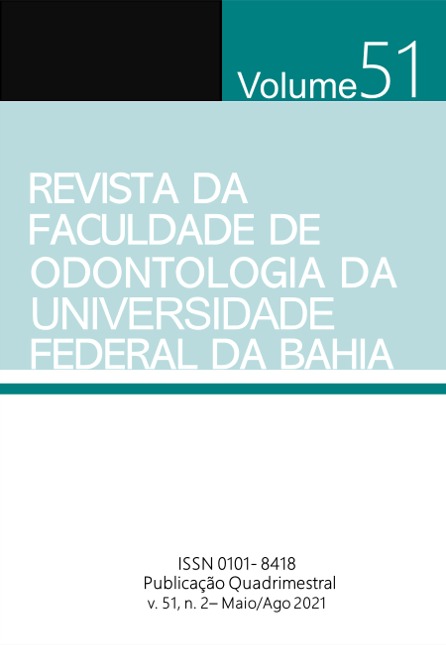FRENECTOMIA LABIAL ASSOCIADA AO ENXERTO DE MUCOSA MASTIGATÓRIA: RELATO DE CASO CLÍNICO LABIAL FRENECTOMY ASSOCIATED WITH MASTIGATORY MUCOSA GRAFT: CLINICAL CASE REPORT
DOI:
https://doi.org/10.9771/revfo.v51i2.46650Resumo
Os freios labiais se originam da superfície interna dos lábios e inserem-se
na superfície externa do periósteo. Nos recém-nascidos os freios labiais
exercem funções de sucção, deglutição e amamentação. Contudo, nos
adultos, suas funções restringem-se apenas a auxiliar a limitação da
movimentação dos lábios. O freio pode ser considerado não funcional e
estaria indicada sua remoção quando: apresenta inserção papilar, está
associado à presença de diastema, se torna um obstáculo para
manutenção da higiene oral ou causa isquemia da margem gengival.
Objetivo: Este trabalho tem por objetivo discutir as indicações da
frenectomia labial através da apresentação de um relato de caso clínico.
Descrição do caso: Paciente do gênero feminino, 14 anos de idade, por
indicação do ortodontista procurou a Escola Bahiana de Medicina e Saúde
Pública para avaliação do freio labial. Ao exame clínico, foi detectada a
presença de um freio teto labial persistente associado à diastema
interincisal, e indicada a frenectomia labial durante o tratamento
ortodôntico. A técnica escolhida para remoção do freio foi a do “duplo
pinçamento”. Em função do grande volume do freio, foi feito um enxerto de
mucosa mastigatória (EMM) imediatamente após a frenectomia.
Conclusão: A técnica de frenectomia associada ao EMM foi eficiente em
promover remoção do freio preservando a estética da região,
proporcionando conforto e condição anatômica para controle de placa, e
fechamento do diastema interincisal mediano, com previsibilidade e
estabilidade.
The labial frenum originates from the inner surface of the lips and are
inserted into the outer surface of the periosteum. In newborns, the labial
frenum are responsable for suctioning, swallowing and breastfeeding
functions. However, in adults, their functions are restricted to merely limiting
the movement of the lips. The frenum can be considered nonfunctional and
its removal is indicated when: it presents papillary insertion, is associated
with the presence of diastema, becomes an obstacle to maintain oral hygiene
and causes ischemia of the gingival margin. Purpose: The objective of this
study is to discuss the indications for labial frenectomy through the
presentation of a clinical case report. Case description: A female patient, 14
years of age, by appointment of the orthodontist, sought the Escola Bahiana
de Medicina e Saúde Pública to evaluate the labial frenum. The clinical
examination revealed the presence of an abnormal labial frenum associated
to the interincisal diastema and indicated to frenectomy during the orthodontic
treatment. The technique chosen to remove the frenum was one called
"double clamping". Due to the large frenum volume, a mastigatory mucosa
graft (EMM) was made immediately after the frenectomy. The case was
accompained for 21 months and the EMM associated frenectomy technique
was efficient in promoting frenum removal while preserving the esthetics of
the region. Conclusions: The patient reported satisfaction with the final result,
since there was closure of the median interincisal diastema.
Downloads
Downloads
Publicado
Como Citar
Edição
Seção
Licença

Este trabalho está licenciado sob uma licença Creative Commons Attribution-NonCommercial 4.0 International License.

